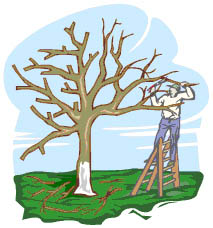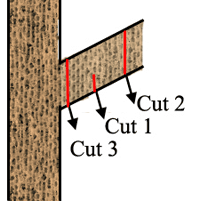
Pruning trees and shrubs can be a crucial management practice that not only promotes healthy plants but also aids with safety around trees. Healthier plants tend to provide more flowers, fruits and/or nuts which can be a huge benefit to wildlife. The following information goes over basics of pruning.
Pruning involves removal of branches and twigs to improve growth and safety of plants. There are four main reasons to prune plants: (1) training the plant, (2) improving plant health, (3) controlling growth and (4) promoting safety.
Training the Plant
Pruning plants can be beneficial in training the plant to grow in a desired form. Some pruning practices promote bushier plants while others promote the abundance of flowers or fruit. In terms of species like cedars and sweet gums which have a central leader, little pruning is necessary other than to get rid of shoots which may compete with the central leader.
Improving Plant Health
If you notice dead or dying branches on your tree or shrub that show sign of disease or severe insect infestations, then many times it is best to remove them from the plant. Furthermore, damaged branches due to animals, storms or other forces should also be removed to promote plant health. Branches which rub together can cause problems with your trees or shrubs, so removing them helps promote healthier plants and prevents weak branches from developing. Removing excess branches can also improve the quality of flowers or fruit. For example, pruning decreases the amount of material the plant itself has to sustain, so by having fewer branches with fruit, then more energy can be placed in making the fruit than maintaining lots of branches.
Controlling Growth
Over time, plants tend to grow larger, and sometimes, the growth can exceed space allotted for plants. When space is limited, regular pruning of branches is often necessary. While pruning can help control plant growth, it is important to choose your plants wisely for the space they are intended to grow in.
Promoting Safety
Old trees and their branches can be safety hazards. Therefore, one reason to prune would be to remove dead branches and trees which may be a safety hazard. Weak or narrow-angled branches that hang over homes parking areas and/or sidewalks should also be pruned to eliminate possible injury to people or property. Branches which also obstruct views or signs at road intersections should also be pruned. DO NOT prune near electrical or utility wires, however! Contact utility companies or city maintenance workers to tackle branches or trees that interfere with power or utility lines.
Tools of the Trade

Many tools are available to assist people with pruning trees. The type of tool used depends on the job at hand. If you are pruning branches up to ½ inches in diameter, then simple pruning shears will do. Pruning shears have small handles, so if you need to reach then lopping shears are better to use. Lopping shears generally can cut branches up to 2 inches thick. Pole pruners are also available for hard to reach pruning jobs.
Pole pruners can reach several feet in the air and consist of a hooked blade above and a cutter beneath. Generally, the cutter is operated by pulling a lanyard. Poles can be made of a variety of materials from wood to fiberglass. Many times, these are hard to handle pruners and come with the danger of material falling down on the operator.
Pruning saws are best used for larger limbs. Pruning saws can be bow saws or fixed-blades. Blades on these saws can be straight or curved. Curved saws are beneficial due to the fact that they cut on the draw stroke. For the really tough jobs, chain saws are the best tool and are suitable for tree removal in addition to pruning. When using a chain saw, it is important to wear safety glasses and protective clothing.
General Pruning Techniques
In general, pruning is best accomplished in the winter. However, evergreens can be pruned anytime of the year. In addition, trees and shrubs that flower in early spring (eastern redbud, dogwood, serviceberries etc.) should be pruned immediately after flowering.
When pruning twigs and small branches, it is best to prune the plant back to an intersecting branch or vigorous bud. If you choose to cut to the bud, then choose a bud which is pointed in the direction you want the new growth to pursue. When cutting to an intersecting branch, choose a branch that forms an angle less than 45 degrees with the branch you are removing.

If you are removing a larger branch, then the cuts should be flush with the collar of the branch. The branch collar is a bulge formed at the base of a branch by the annual production of overlapping layers of branch and stem tissues. Sometimes the branch is referred to as the “shoulder”. This type of cut simulates the area where trees would naturally shed their branches. If you cut past the collar, then the protective zone of tissue is removed, making the plant susceptible to fungi and disease. If the cut will be over 1.5 inches in diameter on a live branch, then it is best to use a 3-part cut. For the 3-part cut, you should saw the bottom of the branch 6-12 inches from the trunk, a third of the way through the branch. This cut prevents the falling branch from pulling stem tissue away from the tree. After that, make a cut on the top approximately 3 inches out from the first, leaving a stub on the tree. The final cut should then cut the branch stub off at the collar.
Trimming dead branches is generally much easier than live branches as the collar is much more evident. Even with dead branches, care should be taken not to damage the collar or the living bark tissue on the main stem of the plant.
Pruning Mistakes to Avoid
- Do not cut a branch in the middle; make cuts back to a bud, branch, or main trunk.
- Do not paint the cut after pruning.
- Do not remove more than 25% of the leaf surface of the plant in any one year.
- Do not cut into a living tree collar.
- Do not make cuts flush with the trunk or parent branch.
- Do not prune trees or shrubs touching utility or power lines.
- Do not forget to sanitize pruning equipment in between trees and shrubs.
For more detailed information on pruning trees, check out the USDA publication here:
http://www.na.fs.fed.us/spfo/pubs/howtos/ht_prune/htprune.pdf
Invite Wildlife to Your Backyard!
For more information, please contact:
Maryland Department of Natural Resources
Wildlife and Heritage Service
Tawes State Office Building, E-1
Annapolis MD 21401
410-260-8540
Toll-free in Maryland: 1-877-620-8DNR
[email protected]
Acknowledgements:
- Photo of woman using pole pruners, by Kerry Wixted